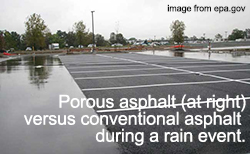 Parking lots are a necessary evil. For a nation built on personalized mobility, rather than the mass transport that is ubiquitous and well-loved across Europe, we need places to store our cars while we’re off shopping, working, and exercising at the gym (since cars are immobile 95% of the time). Yet for all of the societal, environmental and aesthetic ills pinned on the forlorn parking lot, recent innovations in parking lot design may just pave the way for a more positive relationship between people and our parking spots.
Parking lots are a necessary evil. For a nation built on personalized mobility, rather than the mass transport that is ubiquitous and well-loved across Europe, we need places to store our cars while we’re off shopping, working, and exercising at the gym (since cars are immobile 95% of the time). Yet for all of the societal, environmental and aesthetic ills pinned on the forlorn parking lot, recent innovations in parking lot design may just pave the way for a more positive relationship between people and our parking spots.
Porous Parking Lot Designs are Green & Safer for Drivers
Traditional designs allow rainfall and runoff to flow along the pavement surface, draining into adjacent catch basins and/or ditches of roads or parking lots. Porous asphalt pavement instead allows rainfall and runoff to flow into and through the pavement structure, providing an alternative practice to stormwater management and run-off control. As a result, parking lot surfaces can collect and/or slow the rate of run-off from other impervious surfaces.
The environmental and safety benefits of porous pavements include:
- Water treatment/ pollutant removal
- Reduced or eliminated need for curbing and storm sewers
- Recharge local aquifers
- Stormwater management
- Improved skid resistance
- Reduction of spray to drivers and pedestrians
- Potential for noise reduction
Today, porous pavements are just a small fraction of all parking lot designs. However, their popularity is steadily increasing on a percentage basis, and they have been installed in all regions of the United States.
Warm Mix Asphalt Parking Lot Designs are Cheaper & More Green
Traditional asphalt (called “hot mix asphalt”) is heated above 300°F and kept hot during transport by truck. This hot mixture emits noxious gasses that can be harmful to workers and the environment. A new alternative to this process uses the exact same materials, with a new method to prepare all asphalt mixes using significantly lower temperatures. Although this process is relatively new to the U.S., it has been successfully proven through more than 10 years of use across Europe.
Using a variety of technologies to produce, place and compact asphalt at temperatures that are 30 to 120 degrees cooler, without compromising quality or performance, warm mix asphalt (WMA) can cut fuel consumption and costs while decreasing the production of greenhouse gases.
The extensive benefits of warm mix asphalt for parking lots include:
- Extended Paving Season + Night Paving: WMA cools more slowly, allowing it to be successfully placed in lower temperatures – which enables an extended paving season and makes night paving more feasible.
- Saves Time: Less time needed for production and to surface roads
- Saves Costs:
- Less time and labor are spent compacting the mix.
- Lower temperatures also permit more asphalt mix to be hauled for longer distances, reducing transportation costs.
- Reduced Fuel Consumption: less fuel is needed to produce WMA because less energy is needed to heat the asphalt mix. Fuel consumption during WMA manufacturing is typically reduced by 20%.
- Healthier Working Conditions: Both at the production plant and on the construction site, workers inhale far less smoke and dust.
- Fewer Emissions: Makes it possible for paving to be done on some days when the air quality would typically put a halt to paving.
To find out how to estimate porous pavement or warm mix asphalt parking lot design innovations for your next project, contact Basic Construction at (757) 249-3789 or download our FREE ebook for tips to help “Estimate Your Project Right the First Time.” Download the free guide now!


